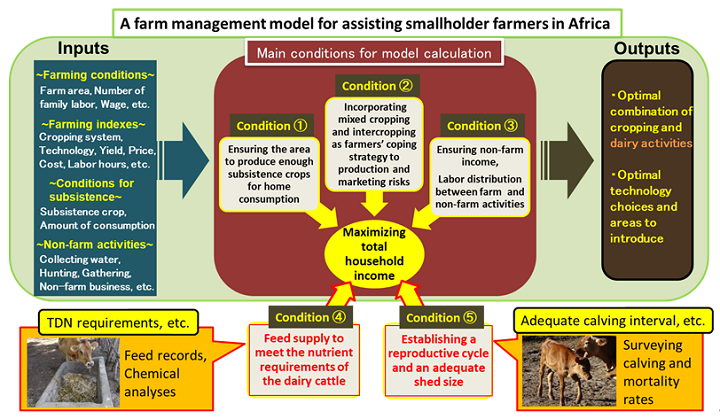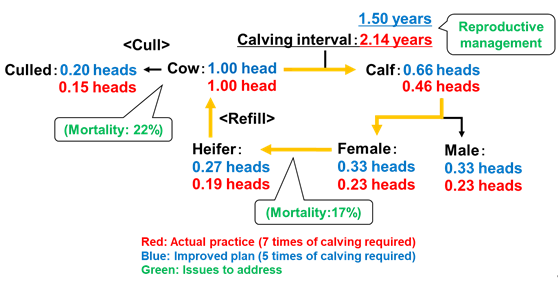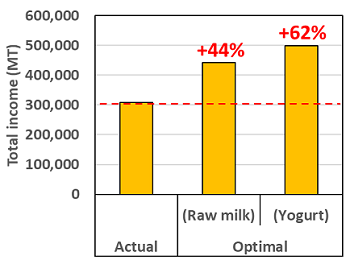An integrated crop-livestock farm management model that can meet the reproductive conditions of dairy cattle in Mozambique
Description
In southern Mozambique, development programs have promoted the provision of exotic dairy cattle coupled with technical and marketing assistance to smallholder farmers to complement their cropping activities, improve income, and meet the increasing demand for milk products in the country. However, sustainable dairy production and integration with crop production is still limited. This study unravels the major constraints to sustainable dairy cattle farming in the Manhiça district of Maputo Province, where Jersey cattle was imported from South Africa and offered to farmers through development programs. To support farmers in making decisions, the study also develops an integrated crop-livestock farm management model to efficiently secure food and feed and improve income through crop-dairy interactions.In addition to the three conditions regarding farmers’ demands for food, risk management, and non-farm activities integrated into “A farm management model for assisting smallholder farmers in Africa” (https://www.jircas.go.jp/en/publication/research_results/2018_b02), the model developed in this study integrates the following conditions regarding dairy production: adequate feed supply that can satisfy the nutrient requirements of dairy cattle, proper herd structure that enables animal reproduction, and sufficient shed space (Fig. 1). Using a mixed integer programming method, the model is designed to simultaneously identify the optimal cropping system and dairy herd size to maximize total farm income while meeting food and feed requirements. From a structured questionnaire survey of all dairy cattle farmers in the Manhiça district (70 households), we found that the farmers face considerable difficulty in establishing a reproductive cycle due to high mortality and long calving interval of dairy cattle caused by infectious diseases and lack of artificial insemination (Fig. 2: red). The results of the model analysis applied to a representative dairy farm in the district show that once the calving interval is significantly shortened by reproductive improvement (Fig. 2: blue), the farm can keep three cows and one heifer calf and feed them enough to maintain actual productivity through effective use of crop residues, while producing enough food to meet household demands. Compared to actual farming, optimal crop-dairy farming (Table 1) will increase total income by 44%, or by 62% if the farm additionally processes the harvested raw milk into yogurt (Fig. 3).
The developed model can be used to i) support farmers’ decisions to improve dairy cattle keeping and integration with crop enterprises, ii) support policy decisions to finance health and reproductive improvements of dairy cattle by informing the expected economic benefits to farmers, iii) identify the optimal dairy-crop interactions using newly developed cropping and/or feeding technologies along with their likely impacts on farmers’ food security and income status.
Figure, table
-
Fig. 1. An integrated crop-livestock farm management model developed in this study
-
Fig. 2. Reproductive conditions of dairy cattle in the Manhiça district
Under the current conditions (red), for every heifer, 0.19 cows are refilled for succession per year, while 0.15 cows are culled given the mortality rate during the service (22%). This situation calls for seven offspring to maintain the herd, which takes about 15 years of service life with a calving interval of 2.14 years. If the calving interval is reduced to 1.5 years by reproductive improvement (blue), the required calving number becomes 5, and the service life is reduced to 7.5 years.
-
Table 1. Optimal cropping system and dairy herd size of a representative farm in the Manhiça district
Actual Optimal Cropping (ha) Cassava + Maize + Cowpea + Peanut + Pumpkin mixed cropping 0.22 0.24 Maize + Cowpea + Peanut mixed cropping 0.33 0.32 Maize + Sweet potato + Sugar cane + Pumpkin mixed cropping 0.48 0.70 Maize + Sugar cane + Banana + Pumpkin mixed cropping 0.28 0.89 Others 0.84 0 Dairying (head) Jersey cow 1 3 Jersey heifer calf 3 1 Actual: Actual crop and dairy farming by the farm
Optimal: Optimal crop and dairy farming identified by the model -
Fig. 3. Expected income increase by introducing optimal cropping system and dairy herd size
Actual, Optimal: Same as Table 1
MT: Metical (currency of Mozambique) Rate of income increase is indicated above
- Affiliation
-
Japan International Research Center for Agricultural Sciences Social Sciences Division
- Classification
-
Research
- Research project
- Program name
- Term of research
-
FY2020(FY2018~FY2020)
- Responsible researcher
-
Koide Junji ( Social Sciences Division )
ORCID ID0000-0003-1726-4400Oya Tetsuji ( Crop, Livestock and Environment Division )
Matsumoto Takeshi ( Risk Management Office )
Tinga Benedito ( Agricultural Research Institute of Mozambique )
- ほか
- Publication, etc.
-
Koide J and Tinga B (2020) Tropical Animal Health and Production, 53:130https://doi.org/10.1007/s11250-020-02547-5
- Japanese PDF
-
2020_B06_A4_ja.pdf621.91 KB
2020_B06_A3_ja.pdf621.39 KB
- English PDF
-
2020_B06_A4_en.pdf866.27 KB
2020_B06_A3_en.pdf912.87 KB
- Poster PDF
-
2020_B06_poster.pdf555.12 KB
* Affiliation at the time of implementation of the study.



